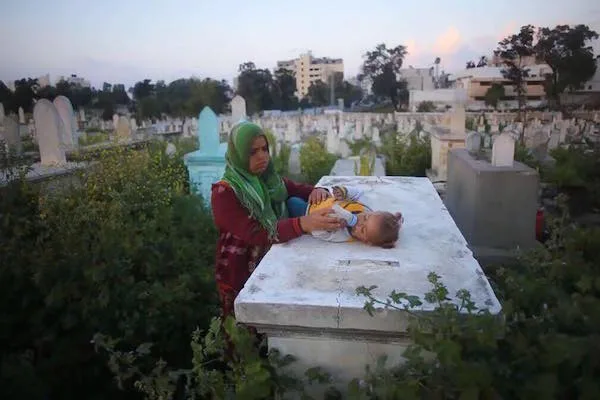The humanitarian crisis in the Gaza Strip has reached a grim, unprecedented level, as thousands of internally displaced Palestinians are being forced to live in Gaza’s graveyards and open cemetery spaces.
Following continuous bombardment and the massive destruction of residential areas, a severe lack of safe shelters has driven desperate families to erect makeshift tents between tombstones in locations like Khan Yunis, turning burial grounds into the last resort for the living.
This horrifying development starkly highlights how the humanitarian crisis deepens, underscoring the catastrophic dire living conditions for displaced civilians trapped within the besieged enclave.
Headline Points
• Humanitarian Crisis Deepens: The dire scarcity of safe and suitable shelters forces huge numbers of displaced families to occupy graveyards.
• Lack of Safe Shelters Forces Families into Cemeteries: Families, unable to afford transportation or rent space in overcrowded UN shelters, are choosing cemetery grounds as a last, desperate option.
• Dire Living Conditions for Displaced Civilians: Families residing among the dead face severe lack of clean water, sanitation, and protection from disease, heat, and venomous wildlife.
The New Reality: “Living with the Dead”
For the displaced, the choice to seek refuge in a graveyard is not a conscious one but a tragic necessity.
With the ongoing expansion of Israeli military operations and the shrinking of habitable and designated safe zones, areas such as cemeteries represent the few remaining plots of open ground where families are not immediately charged for space.

Reports from aid workers and local journalists paint a harrowing picture, with many describing the situation as “running from death to death.”
One displaced mother, Umm Mohammed Abu Shahla, who fled from Beit Lahia in northern Gaza, articulated the desperation:
“We could not find any place other than the cemeteries. Every place we went was full of people. We live with the dead, and the living are like the dead now. Even the children no longer care.”
This sentiment reflects the profound psychological toll on a population stripped of all normalcy.
The cost of safe movement and temporary shelter has skyrocketed due to the intense demand and scarce resources.
According to aid agencies, transport and basic shelter components can cost families thousands of dollars, a figure far beyond the reach of most.
Consequently, those with no economic means are left to construct flimsy shelters from salvaged cloth and plastic sheeting right next to graves, often in areas already targeted by previous conflict.
Health, Environmental, and Psychological Hazards
The dire living conditions for displaced civilians in the cemeteries exacerbate an already critical health and safety emergency:
• Sanitation and Water Crisis: Graveyards lack any form of infrastructure. Displaced families have no access to clean drinking water or proper sanitation facilities.
Children and women must walk miles daily to collect minimal, often unclean, water supplies. This desperate lack of sanitation is a breeding ground for waterborne diseases and other epidemics, a major concern for relief organizations working in Gaza.
• Environmental Dangers: These areas, often adjacent to open desert or agricultural land, expose families to extreme heat and pose significant safety risks, particularly from venomous creatures like scorpions and snakes.
The exposed environment offers no protection against the elements, making the elderly and young children highly vulnerable.
• Psychological Trauma: The psychological impact of residing amongst the dead is devastating, especially for children.
Their daily lives are defined by the visible markers of mortality, contributing to deep-seated trauma and psychological distress that aid agencies warn will require decades of recovery efforts.
The international community, though repeatedly calling for humanitarian access and a ceasefire, has yet to find a solution to the critical shortage of safe and humane shelter options.
The scene of Palestinian children playing amidst the tombstones serves as a haunting symbol of a human catastrophe demanding immediate and unprecedented global intervention to alleviate the suffering of Gaza’s displaced population.
The ongoing displacement crisis necessitates the urgent designation and protection of genuinely safe humanitarian zones, far removed from the constant shadow of the conflict.
